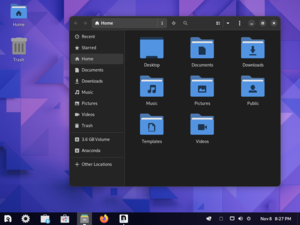Nobara Linux
 | |
 Screenshot of nobara with GNOME Shell | |
| Developer | Thomas Crider, Community-driven |
|---|---|
| OS family | Linux (Unix-like) |
| Working state | Current |
| Source model | Open source |
| Initial release | July 10, 2022[1] |
| Latest release | 40 |
| Repository | gitlab |
| Package manager | RPM (DNF), Flatpak, OSTree |
| Platforms | |
| Kernel type | Monolithic (Linux kernel) |
| Userland | GNU |
| Default user interface | GNOME Shell, KDE Plasma 6, Bash |
| License | Various free software licenses, plus proprietary firmware files[6] |
| Official website | nobaraproject |
Nobara Linux[7] is a Linux distribution based on Fedora Linux,[8] it is developed by Thomas Crider, otherwise more colloquially referred to as "Glorious Eggroll",[9] who is also known for developing Proton-GE.[10]
History
[edit]Nobara Linux was first released on July 10, 2022.[1] It was developed and maintained by Thomas Crider, previously employed as a software maintenance engineer at at Red Hat, working in Denver, Colorado, United States.[11]
Features
[edit]Nobara Linux aims to provide users who are less technologically skilled with commonly used packages, due to the original Fedora Linux having "3rd party or proprietary packages is usually absent from a fresh install."[12] as stated on the official Web site. Claiming that most "point and click users" who rely heavily on graphical user interface installation processes and activities, may struggle with such tasks. Packages commonly used by gamers or in gaming-related activities are not installed by default. As mentioned on the official Nobara site, "WINE dependencies, obs-studio, 3rd party codec packages such as those for gstreamer, 3rd party drivers such as NVIDIA drivers, and even small package fixes", along with other features are not explicitly mentioned, but designed to improve the user experience primarily for gamers.[13]
Installation
[edit]The official Nobara Linux site supplies ISO images that can be run using a bootable USB device. The site recommends that one use the Ventoy utility to create a bootable USB device. The Linux distribution is offered in five desktop environments; Official (modified KDE), GNOME, KDE, Steam-HTPC (modified KDE, customized to look/feel like Steam Deck; built for HTPCs) and Steam-Handheld (modified KDE, customized to look/feel like Steam Deck; built for Handheld devices).[14]
SecureBoot must be disabled in BIOS on the target machine, as Nobara does not support it.[15]
References
[edit]- ^ a b "Changelog – Page 4 – Nobara Linux | The Nobara Project". 2022-07-10. Retrieved 2024-01-07.
- ^ a b "Downloads". Nobara website. 7 January 2024.
- ^ "Announcing the release of Fedora 28". Fedora Magazine. 1 May 2018. Archived from the original on 25 July 2018. Retrieved 24 July 2018.
- ^ "Architectures". Fedora Project. Archived from the original on 14 July 2011. Retrieved 22 March 2018.
- ^ "alt architectures". Archived from the original on 14 December 2017. Retrieved 22 March 2018.
- ^ "Frequently Asked Questions about Fedora Licensing". Fedora Project. Archived from the original on 6 September 2015. Retrieved 27 March 2014.
- ^ "Nobara Linux | The Nobara Project". Retrieved 2023-07-15.
- ^ "Nobara is the Fastest Growing Linux Distro for Gaming - Boiling Steam". 2023-06-11. Retrieved 2023-07-15.
- ^ McGinty, JT (25 October 2022). "Nobara Linux: A Bleeding-Edge Gaming Distro for Linux Beginners". MakeUseOf. Retrieved 3 June 2024.
- ^ "What Is Proton GE and How Does It Improve Game Compatibility on SteamOS and Linux?". MUO. 2022-10-31. Retrieved 2023-07-15.
- ^ Proven, Liam. "Nobara Project aims to make Fedora 35 viable for gaming". www.theregister.com. Retrieved 2023-07-15.
- ^ "Nobara Linux | The Nobara Project". Retrieved 2023-07-15.
- ^ "Nobara Linux: A Bleeding-Edge Gaming Distro for Linux Beginners". MUO. 2022-10-25. Retrieved 2023-07-15.
- ^ "Download – Nobara Linux | The Nobara Project". 2024-09-23. Retrieved 2024-09-23.
- ^ "FAQ – Nobara Linux | The Nobara Project". 2023-04-21. Retrieved 2024-08-04.
External links
[edit]{{Fedora Linux derivatives}
